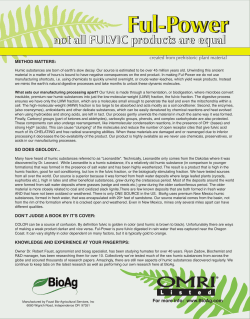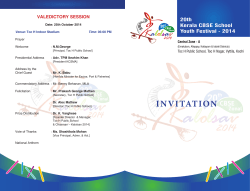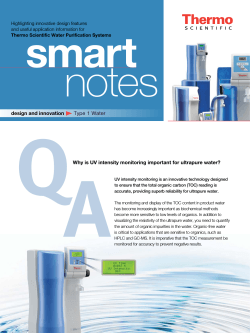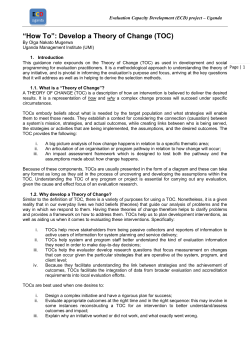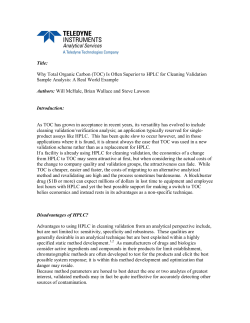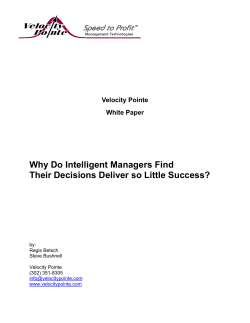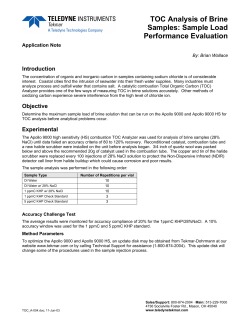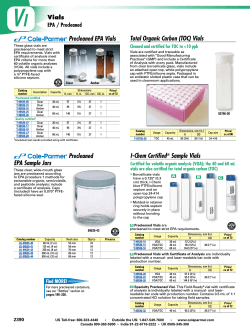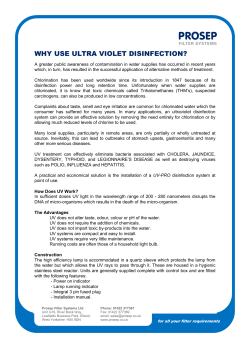
TOC Analysis of Humic Acid: Sample Preparation is the Key Introduction
TOC Analysis of Humic Acid: Sample Preparation is the Key Application Note By: Brian Wallace Introduction Measuring the amount of natural organic matter (NOM) in sources of surface waters has been of particular interest for municipal drinking water purification and wastewater facilities. When raw water containing NOM is chlorinated in the disinfection process, potential carcinogens known as disinfection by-products (DBPs), such as trihalomethanes and haloacetic acids, are formed. In an effort to reduce NOM before disinfection, a direct correlation between total organic carbon (TOC) and NOM has been established per Standard Methods 5310 and the USEPA’s disinfectants/disinfection by-products rule. With the increased importance placed on TOC analysis of source water, a historical question of how much NOM can be recovered using TOC has resurfaced. Humic acid, a component of NOM, has been suggested as a standard for mimicking NOM in the laboratory. However historically, persulfate oxidation TOC analyzers have shown an acceptable recovery rate, 80–85%, for this difficult compound.1,2 Modern persulfate TOC analyzers have shown even better recovery, 90–95%, with the use of optimized UV lamps and stronger concentrations of the persulfate reagent. However, no paper to date has fully explored and documented the root causes for variations in recovery in these analyzers. In this paper, the optimization of a modern UV persulfate TOC analyzer for humic acid recovery was evaluated with a comparison to a modern, high temperature combustion (HTC) TOC analyzer. In the performance of TOC analysis, UV persulfate instrumentation demonstrated 95% recovery of humic acid consistently across a linear range of 1 to 100 ppmC, the range typically found in the NOM of source water. Experimental data showed the key challenge for increasing humic acid recovery was representative sample transfer of this particulated matrix, after the acidification employed in the inorganic carbon (IC) removal step, rather than oxidation of the humic acid. Humic Acid Humic Acid is a component of soil and NOM. Some of the questions of recovery in the past have existed because of the highly complex polymeric properties of humic acids that can vary in form and structure depending on environmental conditions. For instance, humic acids may fold in structure at high ionic strengths and open at low ionic strengths.3 Structures of a neutral molecule may differ from those found in soils and sediments because of the highly deprotonated properties of humic acids in aqueous environments.4 Also, complexation between humic acids and metals or other cations can alter a predicted structure. 5 Humic acid is often used as a key compound for recovery studies. However, making and maintaining accurate humic acid standards is very difficult due to the nature of the sample matrix. Humic acid is insoluble when pH is < 2.6 Therefore when a sample of humic acid is acidified, it is believed that humic acid becomes colloidal and either precipitates and settles, or flocculates and floats.7, 8 IC Removal The two typical TOC oxidation techniques traditionally have different ways of removing IC interferences from the sample. Both techniques must acidify to a pH < 2 to convert all carbonate and bicarbonate forms of IC into carbonic acid, as seen in figure 1. The carbonic acid, also known as dissolved CO2, is then sparged from the sample before the TOC oxidation step. For the HTC instrumentation, the humic acid sample is acidified and sparged to remove IC within the sample vial. This process also stirs the sample before it is injected into the combustion tube, so that it includes insoluble forms of humic acid. With UV persulfate analysis, the humic acid sample is transferred from the sample vial to the IC sparge chamber on the instrument. The sample is then acidified and sparged to remove IC. Sequentially, the ‘sparged’ sample is then transferred to the UV reactor for TOC oxidation. It is theorized that this transfer process may leave a portion of the humic acid sample on the walls of the IC sparger chamber and transfer tubing resulting in lower humic acid recovery. TOC_AP-009.doc; 29-Jul-03 Sales/Support: 800-874-2004 · Main: 513-229-7000 4736 Socialville Foster Rd., Mason, OH 45040 www.teledynetekmar.com Figure 1. CO2 Distribution in Water versus pH 9 Method and Results: TOC Analysis Comparison To prove the theory of sample retention in the IC sparger with the UV persulfate technique, a few experiments were conducted with the Phoenix 8000 UV persulfate TOC analyzer. In the first experiment, IC removal from a humic acid sample was performed in the UV reactor with the UV Lamp off. After IC removal was complete, the UV lamp was turned on and persulfate reagent was added to oxidize the organic carbon. This process would include the insoluble forms of humic acid. Wallace et al. found that this process was effective at recovering 100% of the humic acid TOC portion at 10 ppmC in comparison to HTC oxidation.10 Similar benefits with the UV persulfate technique were attained by Kaplan by extending the length of the oxidation process to increase the oxidation efficiency for humic acids.11 These technical breakthroughs did display an improvement versus older UV persulfate oxidation methodologies. However, having the UV lamp turn off and on during every analysis increases the general time of analysis and may cause increased maintenance on the UV lamp. Therefore, another alternative method was investigated with the UV persulfate technique that would allow the UV lamp to remain on during the entire analysis. A second experiment was conducted which combined removing IC in the sample vial and extending the allowable oxidation time from 4 minutes to 6 minutes. All humic acid samples were run side-by-side for comparison with a HTC oxidation TOC analyzer, the Apollo 9000, at various concentrations exceeding those which might occur in NOM samples (typically 1–20 ppmC TOC concentration). Reagent grade purified water was used as a solvent for a variety of concentrations of the sodium salt of humic acid, from Sigma-Aldrich Chemical Company, which had a carbon assay value of 39.03% carbon.12 Each sample was analyzed with both HTC and UV persulfate oxidation techniques with at least 3 replicates per sample. Precision results are displayed in table 1 and a linearity comparison between HTC and UV persulfate is exhibited in figure 2. TOC_AP-009.doc; 29-Jul-03 Page 2 of 4 HTC Sample (n>3) Result (ppmC) STD (+/- ppmC) UV Persulfate RSD Result (ppmC) STD (+/- ppmC) RSD Recovery 1 ppmC Humic Acid 0.9864 0.0251 2.54% 0.9470 0.0295 3.11% 96.0% 10 ppmC Humic Acid 9.8076 0.1442 1.47% 9.3884 0.1408 1.50% 95.7% 50 ppmC Humic Acid 49.1629 1.4946 3.04% 46.7475 1.7343 3.71% 95.1% 100 ppmC Humic Acid 97.7801 1.4374 1.47% 93.9626 1.1088 1.18% 96.1% 200 ppmC Humic Acid 185.7058 1.0484 0.56% 170.907 0.1709 0.10% 92.0% Table 1. Humic Acid TOC Recovery – HTC vs. UV Persulfate. All samples were acidified and the IC removed from the sample vial on the autosampler. The maximum oxidation time was increased from 4 minutes (default) to 6 minutes on both oxidation techniques. Figure 2. Linear regression of UV Persulfate versus HTC TOC results. Samples include TOC concentrations of humic acid at 1, 10, 50, 100 and 200 ppmC. The linear regression of humic acid sample recovery confirmed that the improvements of the second experiment gave quality results across TOC concentrations 5 to 10 times that found in NOM. These results show that both oxidation techniques for TOC analysis could be used for drinking water samples. However, persulfate oxidation has much lower detection limits, more consistent blanks and a lower amount of instrument maintenance in comparison to the HTC oxidation making it the superior choice for this application. TOC_AP-009.doc; 29-Jul-03 Page 3 of 4 Relationship between Humic Acid and Trihalomethanes (THMs) Because humic acid is partially insoluble at a pH < 2, the particulate TOC fraction has historically been measured with greater accuracy using HTC oxidation technologies rather than UV persulfate. As the data from table 1 and figure 2 shows, modern, optimized UV persulfate TOC analyzers include the particulate portion of NOM in the analysis of TOC. Is, however, the particulate fraction of TOC from compounds in NOM actually important to the prediction of disinfectant by-product (DBP) formation? In a recent study of the disinfection of natural waters, dissolved fractions of TOC, known as dissolved organic carbon (DOC), demonstrated a better prediction of DBP formation, compared to TOC measurements that included the particulate fractions. Najm, et al., studied the relationship between TOC and DOC as predictors of DBP formation.13 Water samples spiked with NOM were analyzed for TOC before disinfection and for trihalomethanes (THMs), a DBP, after a disinfection period of 24 hours. All samples were measured with and without filtration. Their findings demonstrated a significant relationship between filtered samples. On unfiltered samples, the formation of THMs, compared to TOC measured, yielded a ratio of less than 5 µg THMs/mg TOC. Whereas, samples, that were filtered through a 0.45 µm filter before analysis, yielded a significantly higher THMsto-DOC ratio of between 20 and 42 µg THMs/mg DOC. They concluded that DOC was a more appropriate indicator of DBP formation potential in water treatment, than TOC. They theorized that the reaction between disinfectants and leached-DOC content actually formed DBPs, rather than the particulate fraction of TOC.13 In some sense, particulate fractions of TOC, such as in humic acid, may actually become an interference to predicting THM’s generation. In most drinking water utilities, particles are removed during the treatment process.14 Turbidity of settled water is usually less than 1–2 NTU.13 Therefore, it is thought that DOC, not TOC, is actually what is being measured at the point of disinfection. Consequently, the use of DOC samples created either by filtration in the laboratory or by particulate settling in the treatment process, is commonly used for sample preparation and analysis. As described in previously mentioned studies, a reduction in disinfectant by-product formation is most likely obtained by decreasing DOC concentrations through appropriate water treatment. Conclusions The test results clearly show that improving sample transfer of particulated humic acid is the key to higher recoveries. Using similar sample handling techniques, both persulfate and HTC oxidation technologies demonstrated comparable results for humic acid TOC analysis. However, superior low-level TOC accuracy and precision with less maintenance makes the persulfate technique the best technique for drinking water analysis. Although not studied in this paper, future research should be directed towards the relationship between disinfectant byproducts, such as trihalomethanes and haloacetic acids, and their precursors—most notably, determining if there is a preference between TOC (with particulate fraction) or DOC for predicting disinfectant byproduct formation. References 1. 2. 3. 4. 5. 6. 7. 8. 9. 10. 11. 12. 13. 14. Koprivnjak, J.F., et al., Water Res., 1995, 29, 91 Wei, Y., Reavis, J., Meadows, C., Woung, L., and Greenlee, J., Proc. Water Qual Technol. Conf., AWWA, San Diego, CA, 1998, 2-E3 (on CD-ROM). Davis, J.A., Adsorption of natural dissolved organic matter at the oxide/water interface. Geochim. Cosomochim. Acta., 1982, 46, 2381. Gaffney, J.S., Marley, N.A., and Clark, S.B., “Humic and fulvic acids and organic colloidal materials in the environment. In: Humic and Fulvic Acids. Isolation, Structure and Environmental Role, ACS Symp. Ser., American Chemical Society, Washington, DC., 651, 1996, 2. Kubicki, J.D., and Apitz, S.E., “Models of Natural Organic Matter and Interactions with Organic Contaminants”. Organic Geochemistry, 1999, 30, 911. Schulten, H., and Schnitzer, M., “Chemical Model Structures for Soil Organic Matter and Soils”. Soil Science, 162, 115. Langmuir, D., Aqueous Environmental Geochemistry, Prentice-Hall, Upper Saddle River, NJ, USA, 1992, 161. Manahan, S.E., Environmental Chemistry, Lewis/CRC, Boca Raton, FL, USA, 6th edn., 1994, 80. Joyce, R., Takahashi, Y. and Wirth, L., “Application of TOC Analyzer to the ppb-Level Measurement of CO2 Trapped in Ammoniated Steam Condensate” Application Note (Tekmar-Dohrmann) Technical Reprint – 011, Rev. July 1991. Wallace, B., Purcell, M., and Furlong, J., “Total Organic Carbon Analysis as a Precursor to Disinfection Byproducts in Potable Water: Oxidation Technique Considerations”. J. Environ. Monit., 2002, 4,35. Kaplan, L.A., Limnol. Oceanogr., 1992, 37, 1119. Humic Acid Sodium Salt, CAS 68131044, Lot 04607BI. Retrieved July 24, 2003 from www.sigmaaldrich.com. Najm, I., Marcinko, J., and Oppenheimer, J., J. Am. Water Works Assoc., 2000, 92,8,84. Ruehl, K., Water Eng. Manage., 1999,146, 22. TOC_AP-009.doc; 29-Jul-03 Page 4 of 4
© Copyright 2025
